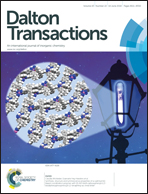Lanthanoid containing phosphotungstates: the syntheses, crystal structure, electrochemistry, photoluminescence and magnetic properties†
Abstract
A series of ten mononuclear lanthanoid containing phosphotungstate clusters were synthesized by the reaction of the dilacunary ligand [P2W19O69(H2O)]14− with Ln(NO3)3·xH2O in a potassium acetate buffer (pH 4.8), leading to the formation of Peacock and Weakley type dimers [Ln(PW11O39)2]11− (Ln = Pr3+ (1), Nd3+ (2), Eu3+ (3), Gd3+ (4), Tb3+ (5), Dy3+ (6), Ho3+ (7), Er3+ (8), Tm3+ (9), and Yb3+ (10)). All isostructural molecular clusters were structurally characterized using various analytical techniques like FT-IR, 31P NMR spectroscopy, photoluminescence and solid state UV/vis, electrochemistry, magnetism and single crystal X-ray diffraction. The compounds crystallize as mixed potassium/caesium or potassium salts K11[Ln(PW11O39)2]·xH2O (Ln = Pr3+ (1a), Nd3+ (2a), Eu3+ (3a), Gd3+ (4a), Tb3+ (5a), Dy3+ (6a), Ho3+ (7a), Er3+ (8a), and Tm3+ (9a), in the monoclinic crystal system, space group P21/c (14) with the exception of the Gd(4a) and Ho(7a) complexes which crystallize in the triclinic system, space group P![[1 with combining macron]](https://www.rsc.org/images/entities/char_0031_0304.gif) . The prominent effect of the paramagnetic lanthanoid ion along the group on the monolacunary Keggin unit (α-PW11O39) was illustrated by FT-IR and 31P NMR spectroscopy. This is attributed to its small size and high charge density (lanthanoid contraction). The photoluminescence of the molecular clusters Eu(3a), Dy(6a) and Ho(7a) was studied at room temperature at different excitation wavelengths and shows interesting photochromic properties. The voltammetric patterns associated with the W-centers in the cluster series have enough distinct features to allow us to establish the relative basicity of the reduced polyoxometalates: {PW11} > Tm(9a) > Eu(3a) ≈ Tb(5a) ≈ Ho(7a) > Gd(4a) ≈ Dy(6a) ≈ Er(8a). Among the lanthanoid cations, just the Eu3+ centre turned out to be electroactive, as expected. The magnetic measurement of Gd(4a) shows the paramagnetic behaviour of the material.
. The prominent effect of the paramagnetic lanthanoid ion along the group on the monolacunary Keggin unit (α-PW11O39) was illustrated by FT-IR and 31P NMR spectroscopy. This is attributed to its small size and high charge density (lanthanoid contraction). The photoluminescence of the molecular clusters Eu(3a), Dy(6a) and Ho(7a) was studied at room temperature at different excitation wavelengths and shows interesting photochromic properties. The voltammetric patterns associated with the W-centers in the cluster series have enough distinct features to allow us to establish the relative basicity of the reduced polyoxometalates: {PW11} > Tm(9a) > Eu(3a) ≈ Tb(5a) ≈ Ho(7a) > Gd(4a) ≈ Dy(6a) ≈ Er(8a). Among the lanthanoid cations, just the Eu3+ centre turned out to be electroactive, as expected. The magnetic measurement of Gd(4a) shows the paramagnetic behaviour of the material.


 Please wait while we load your content...
Please wait while we load your content...